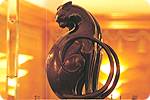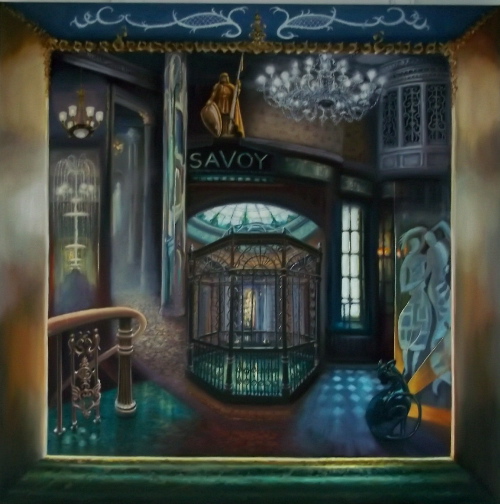Last autumn I began a collaboration with Michelle Tilley, Health and Safety Executive of The Byrne Group to produce a body of work based on two of their current projects – one being the state of the art Shard at London Bridge and by way of contrast – the refurbishment of the much loved old Savoy Hotel on The Strand. This project is almost completed now so time to reflect and share some of the artwork produced exclusively for their head office in Teddington. Due to the nature of the on going work it was impossible to do more on both sites other than take photos and make notes, but as with most of my work a degree of imagination becomes an enormous asset in these circumstances.
The Savoy
Working from photos taken during site visits I produced oil on paper sketches and charcoal studies of each of the sites.
I was fortunate to be able to visit The Savoy just before the furniture was installed and to see the completed interior beautifully lit and this formed the basis for the completed 4′ x 4′ oil painting that resulted. Using details from the interior and gold figure who stands majestically above The Strand entrance, I designed a composition which I hoped would capture the sense of history and the unique mood created by the presence of so many notorious guests and staff. The variety of different styles proved a challenge – how to incorporate the elaborate decoration of the ballroom with the stylish deco chrome pillars and leopard skin patterned carpet with gothic glamour. I have, of course also included the mysterious ‘white lady’ who has been seen disappearing into walls as recently as last year by the security men.
I also included Kaspar the shiny black cat in the lower right hand corner – the story goes that in 1898 a South African diamond magnate by the name of Woolf Joel was visiting London and held a banquet at the famous Savoy before returning home. At the last minute one of his guests had to cancel, leaving thirteen to sit at table, which one guest said was unlucky. After a successful dinner, Joel said his goodbyes and rose to leave; the same guest then said that the first person to leave would also be unlucky and would be the first to die. Joel was not superstitious and thought this remark very amusing — but a few weeks later he was shot dead in his Johannesburg office.
For some years after those events, anxious not to have a similar incident that could damage their reputation, the Savoy provided a member of the hotel staff to sit at tables of thirteen, to avoid the unlucky number, but that idea proved unpopular with guests wanting to talk about personal or private matters; so in 1926 a new solution was found. A British architect and sculptor called Basil Ionides was commissioned to design and carve a three-foot-high model of a black cat, which he produced from a single piece of London plane.
Kaspar in his display case at the Savoy Kaspar awaits a party of diners Named Kaspar, the cat now resides in his own display case in the entrance hall at the hotel, but whenever a party of thirteen requires an extra guest he is brought out to sit at table. He has a napkin tied around his neck and is served every course, just like any other guest. Winston Churchill became very fond of Kaspar, to the extent that he insisted the cat should be present at every meeting of The Other Club, a political dining club he had founded in 1911, and so Kaspar has been at all the fortnightly meetings — always held at the Savoy — since 1927.
During World War 2 Kaspar was catnapped by some mischievous Royal Air Force personnel and flown to Singapore, only to have Churchill himself demand its immediate return!
There are two theories as to the origin of the number thirteen being unlucky. One derives from Norse mythology, in which twelve Gods sat down to a banquet in Valhalla. The evil spirit Loki gate crashed the party as thirteenth member of the party and killed the Gods’ favourite, Balder. Thirteen also has significance to Christians, as there were thirteen people at the Last Supper, and the traitor Judas Iscariot was the thirteenth and last to arrive. As to why a cat — the animals have held an important role in mythology and superstition over the centuries, and black cats in particular are considered by many cultures to be lucky.
The refurbishment began in 2007 and over 1000 craftsmen, artists and builders had been involved in the £100 million re-fit. The whole neo-renaissance limestone facade had to be moved forward by hydraulics 0.75cm – a very complex feat of engineering. The original Edwardian style had previously been updated in the 1930s and these current sumptuous theatrical interior designs are by Pierre Yves Rochon. I was shown the sealed room No 878 where a murder had once been committed and told of the many famous guests who had graced this hotel with their presence; Monet and Whistler (a huge hero of mine) had both painted the splendid view of Thames from the hotels windows, Winston Churchill, The Beatles, Marylin Munro and Richard Harris. I was very gratful to my delightful guide Stuart Harvey, The Project Manager, who explained that the company enforced strict rules about good behaviour and to facillitate this ran an education programme for the 800 strong workforce. A very impressive opperation.
The completed large oil painting took many months and had many transitions before reaching the final composition:
For additional information see:
Gilt trip: Refurbishing the Savoy hotel 8.10. 2010 – Thomas Lane
The refurbished Savoy hotel looks a million dollars – which is just as well because it cost more than £200m to do up. Happily nobody was to blame for the cost and time overruns – except possibly the owner’s insatiably lavish tastes- see images:
http://www.building.co.uk/buildings/gilt-trip-refurbishing-the-savoy-hotel/5006858.article
For a comprehensive history of the Savoy: Wikipedia:http://en.wikipedia.org/wiki/Savoy_Hotel
The Shard
Renzo Piano, the building’s architect, worked together with architectural firm Broadway Malyan during the planning stage of the project. Funder by Qatar the tower will stand 1,017 ft (310 m) tall and have 72 floors, plus 15 further radiator floors in the roof. The building has been designed with an irregular triangular shape from the base to the top. It will be clad entirely in glass. The viewing gallery and open-air observation deck will be on the top (72nd) floor.
Keiren Long of the Evening Standard has written a piece examining the impact that the Shard will have on the area: http://the-shard.com/shard
Andy Bowden – crane operator has also written a piece about the experience of being at the top of his game://www.telegraph.co.uk/culture/art/architecture/8314250/The-Shard-of-Glass-view-from-atop-the-tallest-skyscraper-in-Europe.html
When I first visited the site last year I wrote a blog about the experience of going up the side of the building to a considerable height in a wire cage and The Shard is now almost finished. In fact it is clearly visible from Richmond Park, the Thames at Hammersmith and probably from most of London. It is already truly magnificent! So what a challenge to complete a painting of an incomplete building. It seemed right to show the exposed core while simultaneously showing how the glass membrane will look. when completed on one side. Because the painting is being commissioned by the people building it, I also decided to use the main construction materials to represent the two Byrne brothers – one who specialises in steel and the other in concrete.
The textures that occur on the pillars of concrete are truly lovely and it seemed such a shame to render then with a smooth concrete over layer. The patterns on the raw steel are equally fascinating golden textures which occur as the metal oxidises.
Finding a go











0 Responses to “The Shard & The Savoy – Byrne Bros Project”